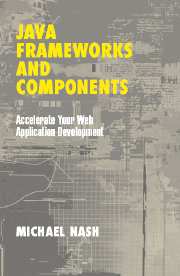Book contents
- Frontmatter
- Contents
- Acknowledgments
- 1 Components and Application Frameworks
- 2 Components: The Future of Web-Application Development
- 3 Application Frameworks: What Do They Provide and What Are the Benefits?
- 4 Choosing an Application Framework
- 5 A Catalog of Application Frameworks
- 6 Comparing Frameworks
- 7 Open Source and Components/Frameworks
- 8 Development Methodologies and Design Patterns
- 9 Integrated Development Environments
- 10 Strategies for Using Frameworks: Best Practices
- 11 Conclusions: The Future of Frameworks and Components
- Appendix: Case Studies
- Glossary
- Index
1 - Components and Application Frameworks
Published online by Cambridge University Press: 28 July 2009
- Frontmatter
- Contents
- Acknowledgments
- 1 Components and Application Frameworks
- 2 Components: The Future of Web-Application Development
- 3 Application Frameworks: What Do They Provide and What Are the Benefits?
- 4 Choosing an Application Framework
- 5 A Catalog of Application Frameworks
- 6 Comparing Frameworks
- 7 Open Source and Components/Frameworks
- 8 Development Methodologies and Design Patterns
- 9 Integrated Development Environments
- 10 Strategies for Using Frameworks: Best Practices
- 11 Conclusions: The Future of Frameworks and Components
- Appendix: Case Studies
- Glossary
- Index
Summary
INTRODUCTION
Welcome, I would like to introduce myself, and discuss the explorations that I would like to take you on in this book. I am a software developer, specifically, an application developer. I build software that people use to get their jobs done – practical, everyday software that is being used.
As part of building applications, in some cases I have also had to build some of the tools I needed including components and an application framework. My programming language of choice for the last several years has been Java. My applications have been targeted for Internet/Intranet uses.
In my exploration, I will examine the nature of software development. It is a complex and demanding process, and developers can use all the tools that are available to them to make it easier and more efficient. We also explore how and why developers resist using those very tools, and how you can make the right decisions in your development projects. It has been a long road, and my hope is to impart some knowledge of its many potholes to you.
I think that I have spent a fair portion of my career in the field resisting the “jargonification” of software development. I am convinced that development can be discussed in plain English, as has been done in this book. It is, however, important to understand the basic terminology used to describe frameworks and components, so we will do this first.
- Type
- Chapter
- Information
- Java Frameworks and ComponentsAccelerate Your Web Application Development, pp. 1 - 34Publisher: Cambridge University PressPrint publication year: 2003



